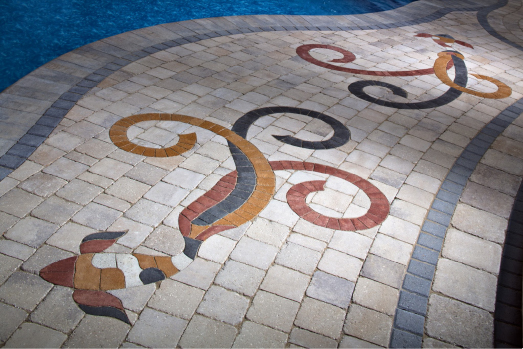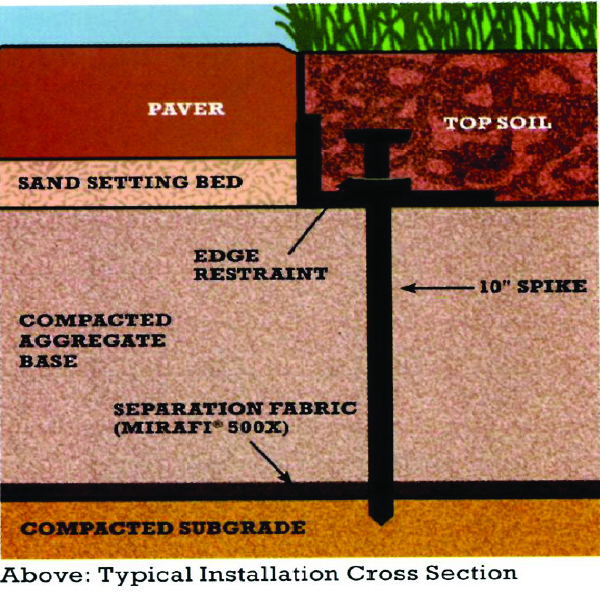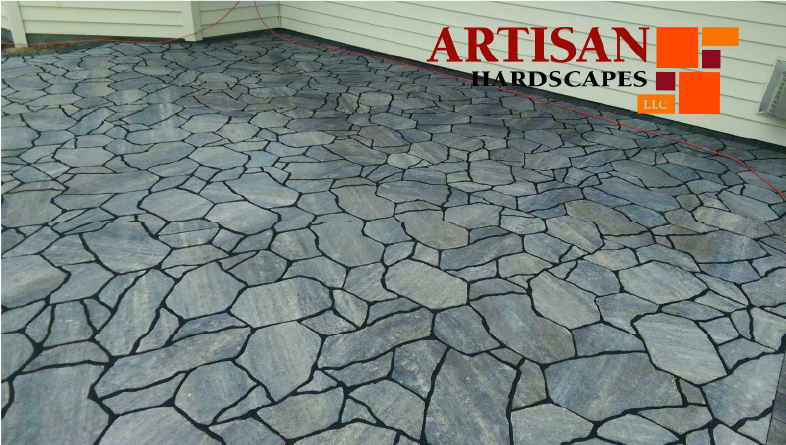Intro (more of a disclaimer)
Within this article I will be discussing interlocking paver systems, but before I do we must first have some context. Some of the information is solid fact; some of the information is my opinion, based on experience and education. My opinion has been developed over 15 years of seeing, installing and experiencing both amazing results and disasters, time in the classroom and learning from grey beards much more experienced than myself. I am only going to touch on a few topics to keep the read relatively short and digestible. I understand that passionate experts can become immersed in a topic while a layman is bored to no end. With this in mind, I am going to try to give you some information you may be seeking. If, by chance, you would like to learn more than what I have written, my contact information is on the website. www.ArtisanHardscapes.net
Paver Patios – What Makes Them Great
Super Customizable

To be completely honest, this aspect of paver patios has gotten so good it is almost detrimental if you aren’t working with a professional. A person can spend countless hours wading through all the textures, sizes, colors and color blends, inlays, patterns and combinations thereof. You can even get pavers that look just like wood planks. Every aspect of your paver patio is customizable, although you may pay more for paver materials for something truly unique. A pro is highly recommended to help you cut through the noise and figure out what you are really looking for.
WOW, You’re Old
A properly installed paver patio may last in excess of 40 years, I used the word “may” intentionally. We have to give the paver patio permission to live up to its maximum potential life span. A paver patio is a series of systems that must all work together to give us the “ sum of the parts is greater than the whole ” effect. There are a few crucial variables, over which we have control, that give our patio a chance at a long life, I will briefly touch on a few here.
The Base. This is the foundation of your paver patio. Its depth, composition, compaction of subsoil, and grade of the excavated area are critical to longevity. Minimum depth of the base should be 6”. I prefer to install at around 8” deep base(deeper in some cases) here in the Red River Valley due to our unusual clay soil composition. The composition of the base material is also critical. It needs to have a few key characteristics. These include: great drainage properties; the ability to hold itself together after compaction; and the ability to withstand compressive forces. Class 5, similar to gravel road material, is commonly used for this, which is fine, but I personally rarely use it for my primary base material. Sand is terrible for paver base and should only be used for paver bedding material and as sparingly as possible, if at all.

The Pavers. This is the part of the paver patio that you see and feel, but they have another equally important and often unacknowledged job. They evenly distribute the load on top of the patio to the base, drain water, endure traffic, endure solar radiation, freeze/thaw cycles, and whatever else our climate has to offer . To do this well for long periods of time, they need to be strong. In fact, to even be technically called a paver a manufacturer must have a batch tested, no individual paver can be weaker than 7200 psi and the batch must average 8000 psi. That is twice the psi of an average concrete slab in your backyard. The interlocking nature of the sizes, shapes, and patterns hold the surface together horizontally while allowing it to flex vertically. The vertical flex of the patio should be nearly undetectable, if the Base is done properly,
The Non-Patio. These are the parts of the paver patio system that are not actually part of the physical patio – elements of the landscape that are usually adjacent to the paver patio and involve water management. Here we need to ask and answer questions about where water is moving onto or under the patio. Does your house roof pitch toward the patio? Are there gutters and are they working? Are there trees in close proximity? Is the grade around the patio draining away? These are just a few of the questions that need to be researched to insure your paver patio has a long life. If you’re working with an expert, you won’t even know these challenges exist.
We Install Pre-Cracked Patios

Individual pavers may break or crack, but it is highly unlikely. If one does, it is cheap and fairly easy to repair. Although, getting an individual paver out of the center of a paver patio can be quite difficult because of their interlocking nature. The main reason paver patios do not crack is because we “install the cracks”. Installing a pre-cracked patio sounds terrible, but it’s actually quite genius. There are two types of concrete. Concrete that is cracked and concrete that is going to crack. How do we solve this unsightly problem? We arrange the cracks into aesthetically pleasing lines, shapes, and patterns. Then we color them and change the name from “cracks” to “joints”. Unlike the cracks in a concrete slab, the joints in a paver patio do serve some important purposes, such as expansion and contraction relief during our climate extremes. As well as a few others related to surface stability.
Timeless Nature

Interlocking and segmental paver systems have been used for thousands of years. Some of the old cobblestone roads and walkways built by the ancient Romans and Chinese still exist today and are still visually appealing. While a paver patio built in your backyard will not last a thousand years, modern concrete products will break down long before that, it can still last 30, 40, 50 years and have relevant style and visual appeal. Just like anything else, it does require effort and maintenance to achieve this. The patio pictured is over 20 years old. It was renewed in 2019 after years of neglect. The color of this paver patio has faded from the affore mention solar radiation, 20 years of direct sun and snow will do that, but 2 coats of a high quality “wet look” semi gloss sealer will bring the colors back to life and complete the restoration.
Open Your Wallet
One of the top ranking Google search phrases related to the subject of paver patios is “Cost Of Paver Patio”, or some variation of that term. Unfortunately, people Googling that term will never get a hard number. The cost of a paver patio can vary wildly; largely because the cost of pavers can vary so wildly. Some pavers can cost as much as some paver patios’ entire installed price. Here, in the Fargo/Moorhead metro, an average paver patio, installed by an experienced hardscape contractor, should cost around $20 dollars per square foot. This price does not include Non-Patio (touched upon above) work. This price assumes quality pavers from an ICPI certified manufacturer and also assumes a patio of at least 200-250 square feet. If you are seeking bids from contractors and some bids are 10% or more below the $20 per square foot price, be skeptical. It is likely that that contractor doesn’t know how to price their product and will cut corners after they figure out they are working for free, or, cut corners are built into the price. Either way, the end result is bad for everyone.
Paver patios initial cost IS and SHOULD be higher than other patio systems. The installation process requires more time and more attention to detail than an average concrete patio. Paver patios require more material for their base and higher quality concrete manufacturing. To put it frankly, an expertly installed paver patio is higher quality. The upside to an expertly crafted paver patio, the relevant potential lifespan of the patio can be twice as long as other patio systems. Taking this into account, the cost of a paver patio is actually less when measured on a per year basis over the lifespan of the patio. This is possible because paver patios are renewable. The tear out, disposal and re-installation costs are a fraction of the cost of a poured concrete patio. When a poured concrete patios’ lifespan is complete, your back at square one of the construction process. Not so with a paver patio. When a paver patio is in need of renewal, your starting point of the construction process is usually more than half way. More than 90% of the materials you need are already paid for and on site; they just need to be reworked. That’s how paver patios are cheaper over the lifespan of the patio.
Wrap It Up Already!
If you have read this far, you are likely considering the addition of an outdoor living space. It is my opinion that paver patios offer the best value for your money. If you would like to have a discussion, I would be pleased to come to your home. And of course, this would be a no-cost visit. Thanks for reading. I hope you have gained some knowledge and perspective.


